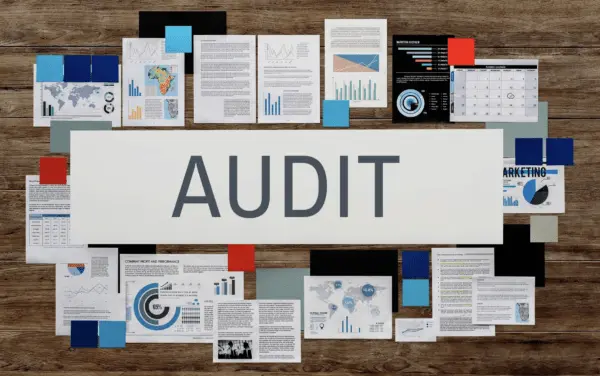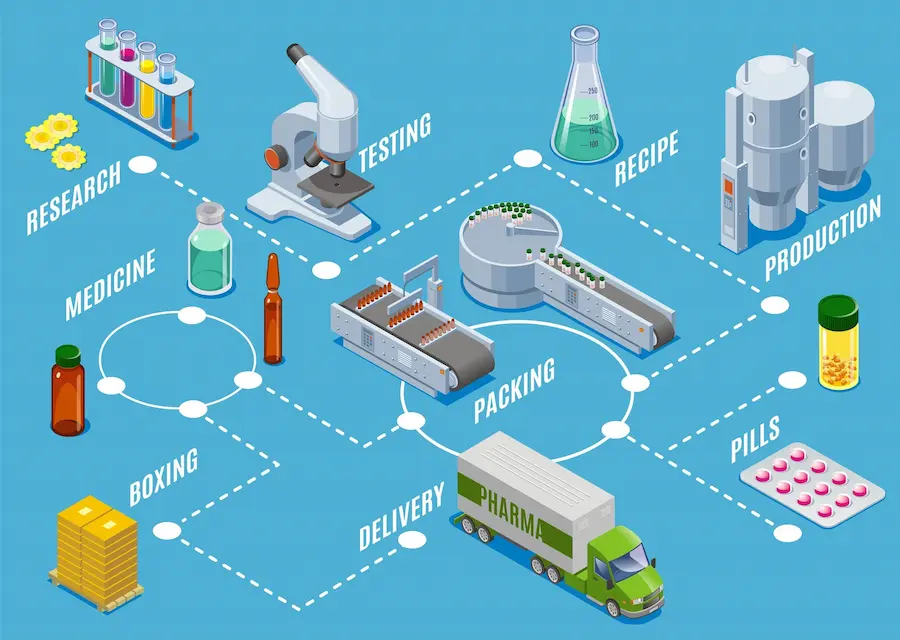Decarbonisation of pharmaceutical companies: how to get started?
Whether you are a pharmaceutical manufacturer or a contract manufacturer, you should be aware that in October 2023, Leem introduced the signing of a collective industry pact. The consensus, entitled ‘Leem’s Decarbonisation Plan’, aims to bring the pharmaceutical industry into line with the objectives of the 2016 Paris Agreements. A study carried out by the union in 2022 estimates that the sector is responsible for 4.4% of global greenhouse gases (GHGs). French drug production alone generates a carbon footprint of 11.8 MtCO2e. In April 2023, the roadmap for the pharmaceutical industry, published by the Conseil National de l’Industrie (CNI), stated that 60% of companies in the sector had not yet undertaken a carbon footprint assessment. While there may be obstacles, there are many benefits to be gained from making the transition. Here’s an overview.
The issues and challenges involved in decarbonising industry
The IPCC’s alarmist reports are calling on nations to significantly accelerate the ecological transition processes already underway in their territories. By 2022, France has committed itself to a goal of decarbonising its industry. This ‘carbon neutral’ strategy targets 4 categories of challenges:
Abandoning carbon, an environmental challenge
Clearly, it is first and foremost the collective interest that is at stake. Reducing greenhouse gases (GHGs) is an altruistic act that marks a commitment to public health and the fight against the harmful effects of global warming.
The energy transition, a regulatory challenge
Faced with an accelerating climate emergency and the condemnation of the ECHR for inaction, public authorities at national and European level are setting their objectives within an increasingly strict legislative framework. Their commitment is set out in several founding texts. These include
- The Paris Agreement (2015) ;
- The Européan Alliance for Green Industry (2019) ;
- The AGEC act (2020) ;
- Climate and Résilience Act (2021) ;
- The National Decarbonisation Pact for french industry(2022).
💡 On 9 April 2024, the ECHR (European Court of Human Rights), in condemning Switzerland for its climate inaction, recognised the right of individuals to be protected by the State, against the harmful effects of climate change.al de Décarbonation de l'Industrie Française (2022).
In France, for example, these requirements take the form of the CSRD directive (Corporate Sustainability Reporting Directive), which came into force on 1 January 2024. The directive requires large institutions (those with more than 500 employees and sales of €50 million and profits of €43 million for two consecutive years) to carry out an energy audit, which they must declare on ADEME’s Bilan GES portal, on pain of a fine of up to €50,000.
A timetable sets out the 3 stages of implementation for each type of company. To date, the regulations are due to come into force for listed SMEs in 2026. It is easy to imagine that a change in the law will require all forms of company to comply by 2030.
Reducing emissions: an economic opportunity
The saying is well known (and particularly relevant to the pharma sector): ‘Prevention is better than cure’. It also takes on its full meaning in the context of the ecological transition, where failure to anticipate has a negative impact. The costs of inaction on climate change are already measurable, and the figures that abound in reports point to clear trends:
- increase in the cost of insurance ;
- a multiplication of the cost of the additional resources needed to adapt to unforeseen disruptions;
- a growing impact on GDP.
While the financing required for the decarbonisation process sometimes hinders the transition to action, it has a real return on investment. In the long term, inaction has a more severe impact on the company’s economy.
The holistic approach of the ONE HEALT concept recognises the inextricable correlation between human, animal and environmental health. It highlights the cyclical effects of dependence on fossil fuels: the contamination of biotopes causes animal diseases which lead to human pathologies. This representation demonstrates the paradox of the pharmaceutical system, which, by polluting, not only increases what it exists to do, but also creates its own obstacles: the increase in extreme weather events, particularly in countries supplying raw materials (Asia, India, etc.) is one of the factors in the supply shortages affecting Europe. The damage caused to crops and production facilities, as well as the higher costs incurred in manufacturing and exporting, have repercussions at every stage of the drug supply chain.
The ecological transition: a measure to ‘stay in the race'
Planning measures in favour of decarbonisation encourages approaches with a systemic effect: for example, one of the ideas put forward is to call on subcontractors who are themselves involved in a 0-carbon strategy. Over and above the moral commitment, decarbonising your business will prove essential to maintaining your competitiveness: not being decarbonised automatically risks taking you out of the loop, on the grounds that you are not contributing to green synergy.
As well as raising the profile of the company, France sees decarbonisation as an argument for attractiveness. The government’s 0-carbon ambitions are combined with the ‘Choose France’ policy: being a pioneer in decarbonised industry and having, by 2025, eco-responsible industrial zones, a decarbonised mix and excellence in decarbonisation technologies should encourage foreign firms to set up here.

Decarbonisation strategies of pharmaceutical manufacturers
In a 2022 study, the Observatoire des Compétences Industries identifies 4 major sources of the pharmaceutical industry’s impact on the environment:
- the environmental footprint of packaging;
- the environmental footprint of logistics;
- the post-use management of products;
- the environmental impact of manufacturing, in relation to products quality and safety standards.
The study also shows that responding to these issues is complicated by :
- the regulatory framework;
- the absence of technical or technological solutions;
- the complexity of value chains and of sourcing products locally (the fact that some French subsidiaries are part of a foreign group limits local R&D).
The Leem industry agreement sets out 3 levers for action (the trajectories are calculated on the basis of companies that have not yet initiated their transition):
- decarbonisation of energy supply;
- decarbonising means of production;
- decarbonising mobility.
Practical measures for the ecological transition
In practical terms, these objectives can be achieved by studying or taking action on :
- Optimising manufacturing processes: reducing waste, in particular by introducing lean management and the Kaizen method.
- Use of green technologies: use of an energy mix or renewable energy sources (low-carbon electricity, self-consumption, green contracts, etc.) and technologies with a low carbon footprint (water recycling, C02 capture, etc.) or geared towards environmental optimisation (sensors dedicated to energy management, cooling, predictive stock management, etc.).
Improving existing buildings: energy renovation, bio-conditioning of buildings (green roofs, shading of facades by plants, night-time ventilation, shading of glass surfaces, etc.) - Eco-design: reducing the quantity of raw materials, improving packaging, stopping single-use packaging, replacing instructions with QR codes, logos showing sorting instructions, etc.
- Waste management: introduction of treatment and recycling systems.
- Optimisation of mobility: replacement of car fleets, short-distance sourcing, improvement of logistics flows, modal shift from air to sea and from road to rail, relocation of activities, employee travel, green fuels, etc.
- Management of suppliers and raw materials: European sourcing, mapping of responsible suppliers, submission of climate commitment charters to service providers, choice of substances with a low carbon footprint, etc.
- The use and integrity of data: rationalising the use of data, environmentally-friendly employment (energy performance management, etc.).
- Improving agility: adopting resilience in decision-making, appointing an energy manager, etc.
Educating employees in energy-saving practices: CUBE competition, in-house team training, etc.
The example of Viatris Laboratories (formerly Mylan) which, from 2013 onwards, was able to anticipate with two key measures:
- Internalising the manufacture of single-dose Betadine at the Mérignac site in France to the detriment of the group’s German plant. The savings achieved, mainly on freight, amount to around 20%.
- Lighter Betadine bottles: by reducing the quantity of plastic in its containers by 1.7g, the laboratory has been able to save 22,500 KgCO2e/year (at a cost of €14.50 per tonne of carbon in 2015).
Source : Ademe
Quicks wins
It’s important to distinguish between important actions and those you can implement quickly. Even if, on their own, they are not enough to achieve the objectives, they have the merit of initiating the process and obtaining tangible returns in a short space of time. These simple technical actions are based on a strategy of optimising existing systems, require little investment and deliver substantial GHG savings.
Common actions include:
- air renewal;
- adjusting the temperature of water or air loops (and other reductions in thermal set points);
- optimising logistics flows and loading;
- efforts to reduce losses (steam network leaks, fugitive emissions, etc.);
- rationalising the use of buildings and mobility;
re-use practices (pallets, raw materials, spare parts, etc.).
In the tertiary sector, the non-investment recommendations put forward by the audits range from 6 to 25% savings on energy bills.
Panpharma, a french pharmaceutical manufacturing , is a good example of this methodology. The company, which produces injectable products, was able to see the benefits of some simple measures at N+1:
- The use of LED lighting with presence detectors in areas with moderate footfall reduced energy consumption by 30% initially.
- Recovering energy losses in the attic of production areas to supply other parts of the building. This represents savings of up to €15,000 a year.
- Recycling energy from air compressors to heat the premises, which has eliminated the need for a boiler.
Source : Ouest-France
Benefits of decarbonisation for small and medium-sized pharmaceutical companies
If we still need to find arguments in favour of taking action at this stage, then let’s summarise the benefits of decarbonisation as follows:
- Reduced operating costs: energy efficiency and less waste, staggering of expenditure thanks to anticipation, avoidance of environmental obsolescence of production tools, use of current subsidies, etc. ;
- Improved competitiveness: attracting customers who are sensitive to an environmental approach, reducing the impact of CO emissions on product prices, gaining the confidence of new buyers, etc. ;
- Independence from energy costs and reduced energy expenditure;
- Regulatory compliance: anticipating stricter legislation and complying with new standards.
- Innovation and financing: access to subsidies and support for the creation of innovative processes.
- Enhancing the company’s image, both internally and externally, by implementing an ecological transition strategy and meeting the requirements of stakeholders: customers, partners, suppliers, etc.
Support for decarbonisation: financial aid available to companies
In France, a number of grants are available to help pharmaceutical SMEs with their decarbonisation efforts. Here are a few examples:
Financial support
- The Industrial Modernisation Fund (IMF) offers grants for investments aimed at reducing greenhouse gas emissions, particularly in the areas of energy efficiency and renewable energy.
- The France Relance programme provides financial support to companies that commit to reducing their greenhouse gas emissions.
- The French Environment and Energy Management Agency (ADEME) offers financial assistance for energy audits and feasibility studies for decarbonisation projects.
Specific aid for pharmaceutical companies
Investment grants are specifically dedicated to players in the pharmaceutical sector. They focus on levers that are not directly linked to the energy transition, but whose implementation may promote it. In fact, preference is given to projects involving the decarbonisation of processes.
The Innovation Health 2030 plan supports the relocation and re-industrialisation of essential medicines and biotherapy.
The Important Project of European Interest in Health (PIIEC), for its part, supports project sponsors in innovating drug production processes through greening. A consultation, open until April 2024, has enabled various project sponsors to submit their applications for consideration.
Decarbonising pharmaceutical companies is no longer an option, but a necessity if the industry is to align itself with the objectives of the Paris Agreements and meet today’s environmental challenges. The measures and 3R strategy (Reduce, Reuse, Recycle) put in place by Leem offer a clear roadmap for significantly reducing CO2 emissions by 2030. The benefits of this transition are manifold, ranging from reduced operating costs to improved competitiveness and corporate image.









